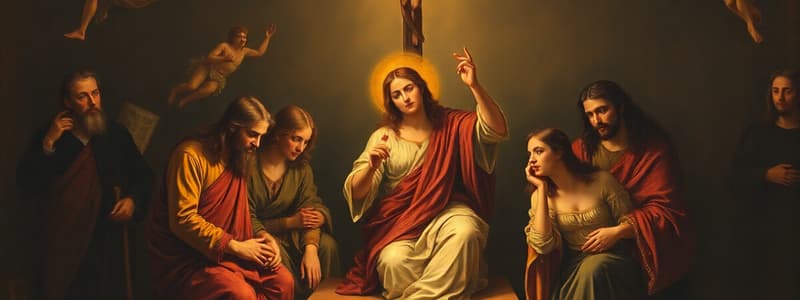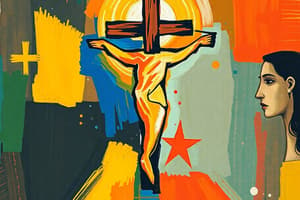Podcast
Questions and Answers
What do Gnostics believe is essential for salvation?
What do Gnostics believe is essential for salvation?
- Accomplishment through secret knowledge (correct)
- Consumption of sacred texts
- Faith in the teachings of the church
- Rejection of material possessions
What was a primary belief of the Ebionites regarding Jesus?
What was a primary belief of the Ebionites regarding Jesus?
- He was one of Israel's prophets. (correct)
- He was the Son of God.
- He had a divine nature.
- He was the reincarnation of a previous prophet.
What key theological term was introduced by the Council of Nicaea to signify the relationship between the Father and the Son?
What key theological term was introduced by the Council of Nicaea to signify the relationship between the Father and the Son?
- Arianos
- Heteroousios
- Monotheos
- Homousios (correct)
How did Nestorius view the nature of Christ?
How did Nestorius view the nature of Christ?
What does the term 'Theotokos' mean?
What does the term 'Theotokos' mean?
What aspect of Jesus did Apollinarius deny?
What aspect of Jesus did Apollinarius deny?
Which council condemned the teachings of Nestorius?
Which council condemned the teachings of Nestorius?
What was Eutyches' view on the natures of Christ after the incarnation?
What was Eutyches' view on the natures of Christ after the incarnation?
Which opponent of Arius argued that the Son is equal in divinity to God?
Which opponent of Arius argued that the Son is equal in divinity to God?
What is meant by the term 'hypostatic union'?
What is meant by the term 'hypostatic union'?
Which council condemned the Monophysites?
Which council condemned the Monophysites?
What is the date when the Second Council of Nicaea condemned Iconoclasm?
What is the date when the Second Council of Nicaea condemned Iconoclasm?
What fundamentally does Iconoclasm deny?
What fundamentally does Iconoclasm deny?
Which saint did Jesus appear to as the Sacred Heart?
Which saint did Jesus appear to as the Sacred Heart?
What is the primary theme of the Christology of John Paul II?
What is the primary theme of the Christology of John Paul II?
St. Bonaventure referred to the crucifix as what?
St. Bonaventure referred to the crucifix as what?
What does the image of the Sacred Heart symbolize?
What does the image of the Sacred Heart symbolize?
What council issued a letter in 1987 addressing Iconoclasm?
What council issued a letter in 1987 addressing Iconoclasm?
According to Catholic teaching, Jesus Christ is considered a human person.
According to Catholic teaching, Jesus Christ is considered a human person.
Karl Barth viewed original sin as a restoration of what?
Karl Barth viewed original sin as a restoration of what?
Flashcards
Ontological Christology
Ontological Christology
Focuses on the identity of Christ.
Functional Christology
Functional Christology
Focuses on Christ's mission as savior.
Ebionites' view of Jesus
Ebionites' view of Jesus
They denied Christ's divinity, seeing Jesus as an ordinary prophet.
Docetists on humanity of Christ
Docetists on humanity of Christ
Signup and view all the flashcards
Gnostic salvation
Gnostic salvation
Signup and view all the flashcards
Council of Nicaea
Council of Nicaea
Signup and view all the flashcards
Homousios
Homousios
Signup and view all the flashcards
Monophysite Heresy
Monophysite Heresy
Signup and view all the flashcards
Hypostatic Union
Hypostatic Union
Signup and view all the flashcards
Theotokos
Theotokos
Signup and view all the flashcards
Jesus' Humanity (Catholic view)
Jesus' Humanity (Catholic view)
Signup and view all the flashcards
Council of Chalcedon's stance on Monophysitism
Council of Chalcedon's stance on Monophysitism
Signup and view all the flashcards
Iconoclasm's meaning
Iconoclasm's meaning
Signup and view all the flashcards
John of Damascus' role (Icons)
John of Damascus' role (Icons)
Signup and view all the flashcards
Second Council of Nicaea (Year)
Second Council of Nicaea (Year)
Signup and view all the flashcards
Catholic reverence for images
Catholic reverence for images
Signup and view all the flashcards
St. Bonaventure and the Crucifix
St. Bonaventure and the Crucifix
Signup and view all the flashcards
Sacred Heart's significance
Sacred Heart's significance
Signup and view all the flashcards
Vatican II's Christology foundation
Vatican II's Christology foundation
Signup and view all the flashcards
John Paul II's Christology theme
John Paul II's Christology theme
Signup and view all the flashcards
Study Notes
Christological Studies
- Ontological Christology: Focuses on the identity of Christ.
- Functional Christology: Focuses on Christ's role as savior.
Early Heresies
- Ebionites: Denied Christ's divinity, viewed him as a prophet.
- Docetists: Denied Christ's humanity.
- Gnostics: Believed salvation came through secret knowledge, with separate categories of saved (pneumatics) and damned (hylics, psychics). Gnostic influence on Docetists arises from their view of the material world and human body as evil.
- Arius: Believed the Son was not equal to God, the Son's divine nature changed.
Ecumenical Councils
- Council of Nicaea (325 AD): Addressed the Arian controversy and established important theological terms.
- Homousios: Consubstantial (Father and Son are God).
- Monogeneis: Only begotten.
- Principal opponent of Arius: St. Athanasius
- Council of Constantinople (381 AD): Condemned Apollinarianism.
- Council of Ephesus (431 AD): Condemned Nestorianism (Jesus had two separate natures).
- Theotokos: Mother of God
- Christotokos: Mother of Christ.
- Council of Chalcedon (451 AD): Condemned Monophysitism (Jesus had only one nature).
- Hypostatic Union: Union of divine and human natures in one person.
- Council of Nicaea (787 AD): Condemned Iconoclasm (opposed to making images of Christ).
Key Theological Concepts
-
Iconoclasm: Rejection of religious images. Condemned by the Second Council of Nicaea.
-
Theotokos: Mother of God (important concept in Christology).
-
Monophysitism: Jesus had only one nature (divine).
-
Nestorianism: Jesus had two distinct natures (human and divine).
Modern Theology and Christology
- Vatican II: Christology grounded in Scripture (Old and New Testaments).
- Christ as Prophet: Mediator and fullness of divine revelation.
- Christ as Priest: Divine sacrifice for sins.
- Christ as King: Sending light to all nations.
- John Paul II: Christology focused on mercy.
- Karl Barth: Incarnation is an invitation into a journey. Original sin was a disruption of covenant.
Additional Notes
- Catholics revere, but do not worship, sacred images.
- Sacred Heart: Represents humanity and divinity.
- St. Bonaventure's view of the crucifix.
Studying That Suits You
Use AI to generate personalized quizzes and flashcards to suit your learning preferences.




